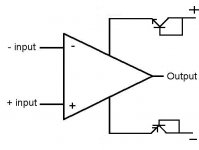More Impressions
I have now done my comparison between my LDR and shunt attenuator.
The attenuator is a 20k shunt attenuator that I built up from a Goldpoint kit a dozen years ago. Interestingly, I must have gotten one of the last kit's Goldpoint put out as they discontinued the shunt and ladder kits in 2004. THe attenuator has a Vishay S-102 resistor in the shunt position and mostly Dale resistors going to ground. The beauty of a shunt attenuator is it's simplicity with the shunt resistor in the signal leg and just one resistor and set of switch contacts in the ground leg. I have used it mostly in my Aspen preamp all these years.
I might add that when I initially built up the attenuator I used it as a passive and it so outperformed my BAT VK30SE preamp that I sold the preamp.
Comparison here was done as was the comparison of a few days ago, though this time I only compared the orchestral piece.
I didn't expect to hear much difference this time around, but then again, I didn't expect much when I compared the series attenuator either. However, this time there wasn't much difference. If anything I found that the massed strings of the orchestra sounded a little richer and fuller with the LDR, but it wasn't much of a difference.
While I was doing the listening here I was trying to pay attention to a few things other than just listening. One thing I tried to focus on was distortion, specifically the small amount of H2 and H3 distortion that has been brought up in the thread. Given that the only thing I could really pick up as a difference in sound was the massed string tone of the orchestra, well perhaps that richer and fuller sound is from the very small amount of H2, I don't know.
Some of the posters in the thread made a great big deal out of the small amount of distortion, but in reality, it's not much.
There is not much more to add. I remain pleasantly well pleased with my LDR attenuator.
I have now done my comparison between my LDR and shunt attenuator.
The attenuator is a 20k shunt attenuator that I built up from a Goldpoint kit a dozen years ago. Interestingly, I must have gotten one of the last kit's Goldpoint put out as they discontinued the shunt and ladder kits in 2004. THe attenuator has a Vishay S-102 resistor in the shunt position and mostly Dale resistors going to ground. The beauty of a shunt attenuator is it's simplicity with the shunt resistor in the signal leg and just one resistor and set of switch contacts in the ground leg. I have used it mostly in my Aspen preamp all these years.
I might add that when I initially built up the attenuator I used it as a passive and it so outperformed my BAT VK30SE preamp that I sold the preamp.
Comparison here was done as was the comparison of a few days ago, though this time I only compared the orchestral piece.
I didn't expect to hear much difference this time around, but then again, I didn't expect much when I compared the series attenuator either. However, this time there wasn't much difference. If anything I found that the massed strings of the orchestra sounded a little richer and fuller with the LDR, but it wasn't much of a difference.
While I was doing the listening here I was trying to pay attention to a few things other than just listening. One thing I tried to focus on was distortion, specifically the small amount of H2 and H3 distortion that has been brought up in the thread. Given that the only thing I could really pick up as a difference in sound was the massed string tone of the orchestra, well perhaps that richer and fuller sound is from the very small amount of H2, I don't know.
Some of the posters in the thread made a great big deal out of the small amount of distortion, but in reality, it's not much.
There is not much more to add. I remain pleasantly well pleased with my LDR attenuator.
thanks a lot stvn for those comparison. im sold, I will try a lightspeed attenuator!
I think you will be well pleased with which ever LDR unit you go with.
Had anyone compared the LDR preamps with those famous TVCs, such as Music First and Townshend?
Last edited:
RPre LDR Switcher
Thought I would share pictures of my latest project build - the RPre by Rudi Ratlos. This too is also an implementation of the LDR - Light Dependent Resistors. A few pics have been shared over on that thread, but I figured I could share them here too.
This project took a while to complete, just due to work schedule and life happening! Not enough time for the hobby. 🙂
I only had 1 little hiccup along the way. I had to replace the IR receiver that was called for with a smaller one that I could get closer to the opening on my front panel. Now the remote works from across the room!
I think it came out pretty good, sound terrific and is very transparent.
Rick
Thought I would share pictures of my latest project build - the RPre by Rudi Ratlos. This too is also an implementation of the LDR - Light Dependent Resistors. A few pics have been shared over on that thread, but I figured I could share them here too.
This project took a while to complete, just due to work schedule and life happening! Not enough time for the hobby. 🙂
I only had 1 little hiccup along the way. I had to replace the IR receiver that was called for with a smaller one that I could get closer to the opening on my front panel. Now the remote works from across the room!
I think it came out pretty good, sound terrific and is very transparent.
Rick
Attachments
-
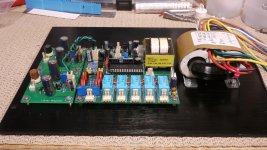 P1120281.jpg525 KB · Views: 519
P1120281.jpg525 KB · Views: 519 -
 P1120306.jpg513.7 KB · Views: 499
P1120306.jpg513.7 KB · Views: 499 -
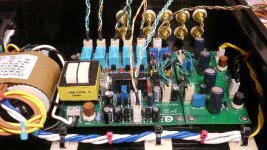 P1120309.jpg533.9 KB · Views: 499
P1120309.jpg533.9 KB · Views: 499 -
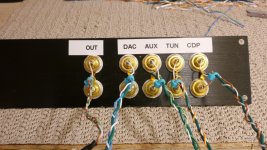 P1120325.jpg528.2 KB · Views: 493
P1120325.jpg528.2 KB · Views: 493 -
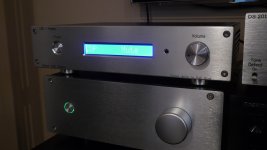 P1120389.jpg286.9 KB · Views: 183
P1120389.jpg286.9 KB · Views: 183 -
 P1120386.jpg267.3 KB · Views: 183
P1120386.jpg267.3 KB · Views: 183 -
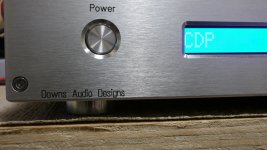 P1120343.jpg603.2 KB · Views: 216
P1120343.jpg603.2 KB · Views: 216 -
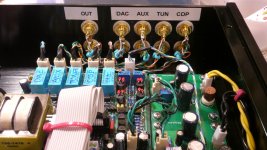 P1120336.jpg488 KB · Views: 216
P1120336.jpg488 KB · Views: 216 -
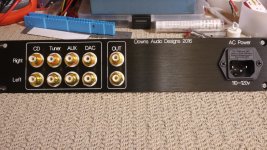 P1120270.jpg592 KB · Views: 488
P1120270.jpg592 KB · Views: 488
Thought I would share pictures of my latest project build - the RPre by Rudi Ratlos. This too is also an implementation of the LDR - Light Dependent Resistors. A few pics have been shared over on that thread, but I figured I could share them here too.
This project took a while to complete, just due to work schedule and life happening! Not enough time for the hobby. 🙂
I only had 1 little hiccup along the way. I had to replace the IR receiver that was called for with a smaller one that I could get closer to the opening on my front panel. Now the remote works from across the room!
I think it came out pretty good, sound terrific and is very transparent.
Rick
Thanks for sharing your project here. I'll be reading up on the project thread for sure.
Hi,
I have now been able to do another comparison of LDR and stepped attenuators with the same stepped attenuator as used in the original comparison in November 2015. The electronics are the same but the room and speakers are different. I did the comparison with the same music as before, and with the addition of a pop music track that I am very familiar with.
At the time of the original comparison the stepped attenuator was my reference and had been in use a long time. The LDR was newly constructed and only a day or two in use at that time. Now the LDR is the reference and I rarely use the stepped attenuator.
The results were different this time.
In the original comparison I heard small differences in the bass, orchestral climaxes/dynamic range, and channel tracking. I heard no tonal differences at that time.
In the new comparison I did not hear any differences in bass, dynamic range or channel tracking. But I did hear a difference in tonal qualities.
The LDR unit has a sound that is rich and full with lots of body. This was especially noted in the pop track with the female voice. The stepped attenuator sounded very good but with a clean and lean sound, again especially heard in the female voice of the pop track.
Several posts in this thread have attested that LDR’s have some second harmonic distortion in them. I would have to attribute the above heard differences to this presence of 2nd harmonic.
As for a choice of preference for musical listening, one has to listen for oneself. I have lived with both. For now however, the LDR is my clear choice for most preferable listening to music.
I have now been able to do another comparison of LDR and stepped attenuators with the same stepped attenuator as used in the original comparison in November 2015. The electronics are the same but the room and speakers are different. I did the comparison with the same music as before, and with the addition of a pop music track that I am very familiar with.
At the time of the original comparison the stepped attenuator was my reference and had been in use a long time. The LDR was newly constructed and only a day or two in use at that time. Now the LDR is the reference and I rarely use the stepped attenuator.
The results were different this time.
In the original comparison I heard small differences in the bass, orchestral climaxes/dynamic range, and channel tracking. I heard no tonal differences at that time.
In the new comparison I did not hear any differences in bass, dynamic range or channel tracking. But I did hear a difference in tonal qualities.
The LDR unit has a sound that is rich and full with lots of body. This was especially noted in the pop track with the female voice. The stepped attenuator sounded very good but with a clean and lean sound, again especially heard in the female voice of the pop track.
Several posts in this thread have attested that LDR’s have some second harmonic distortion in them. I would have to attribute the above heard differences to this presence of 2nd harmonic.
As for a choice of preference for musical listening, one has to listen for oneself. I have lived with both. For now however, the LDR is my clear choice for most preferable listening to music.
If you can hear such subtle differences, maybe you should try SR3 instead of SR2. Datasheets claim it has lower distortion than SR2.
Sent from my SM-G935F using Tapatalk
Sent from my SM-G935F using Tapatalk
If you can hear such subtle differences, maybe you should try SR3 instead of SR2. Datasheets claim it has lower distortion than SR2.
Sent from my SM-G935F using Tapatalk
I'm using the LDR's as supplied by Mort at Tortuga.
Had anyone compared the LDR preamps with those famous TVCs, such as Music First and Townshend?
From owners that have, there are plenty more if you search.
https://forum.audiogon.com/discussi...ator-best-preamp-ever/post?postid=77348#77348
https://forum.audiogon.com/discussi...ator-best-preamp-ever/post?postid=77346#77346
Cheers George
Had anyone compared the LDR preamps with those famous TVCs, such as Music First and Townshend?
I have. Am currently finalising my Sowter 9335 TVC with relay control. The TVC and LDR both show their advantages at low volume settings (compared to potentiometers). I prefer the TVC over the LDR, because it's not a voltage divider that "wastes" most of the signal (by splitting the voltage). Also, the TVC is very low distortion, unlike the LDR.
Hi,
I started this thread over a year ago as I was rather over the moon in my reactions to my newly constructed LDR attenuator. While the thread had its ups and downs one thing that came clear was that LDR’s add 2nd harmonic to the sound.
Since then I have done numerous comparisons between my LDR attenuator and my old preamp, two different stepped attenuators, and even an Alps potentiometer fitted to the living room amplifier that is the same amplifier as the one I have in the music room and used for all the other comparisons.
In the comparisons to the stepped attenuators and potentiometer the only difference I heard is the addition of 2nd harmonic to the sound with the LDR. It’s a bit different with the preamp and I’ve already written about that.
People’s opinions on 2nd harmonic vary, to be sure. Of the harmonic distortions, 2nd harmonic is generally thought to be the “nice” one. There is certainly a bit of 2nd harmonic in an amplifier’s harmonic distortion profile. And if that is the primary component in the THD compilation, people are generally happy.
However, I don’t think one expects to get some 2nd harmonic is a volume control. When one reads in the various places about LDR comparisons LDR’s are always written as being transparent and far better than the previous preamp the owner owned. But never anywhere is there any mention of 2nd harmonic in LDR attenuators.
The reactions in this thread to the addition of 2nd harmonic with LDR’s were varied but mostly bad, as if this 2nd harmonic addition just ruined everything.
However, nonetheless I still prefer my LDR attenuator to my stepped attenuators. I can easily live with either one of them but the LDR does offer some features that cannot be done with a stepped attenuator, like offering fine balance control and very precise volume control. With a stepped attenuator, even mono ones like I have, one is limited by the steps, in my case 2 db. And thus, my preference is still the LDR for volume control in my current music setup.
I started this thread over a year ago as I was rather over the moon in my reactions to my newly constructed LDR attenuator. While the thread had its ups and downs one thing that came clear was that LDR’s add 2nd harmonic to the sound.
Since then I have done numerous comparisons between my LDR attenuator and my old preamp, two different stepped attenuators, and even an Alps potentiometer fitted to the living room amplifier that is the same amplifier as the one I have in the music room and used for all the other comparisons.
In the comparisons to the stepped attenuators and potentiometer the only difference I heard is the addition of 2nd harmonic to the sound with the LDR. It’s a bit different with the preamp and I’ve already written about that.
People’s opinions on 2nd harmonic vary, to be sure. Of the harmonic distortions, 2nd harmonic is generally thought to be the “nice” one. There is certainly a bit of 2nd harmonic in an amplifier’s harmonic distortion profile. And if that is the primary component in the THD compilation, people are generally happy.
However, I don’t think one expects to get some 2nd harmonic is a volume control. When one reads in the various places about LDR comparisons LDR’s are always written as being transparent and far better than the previous preamp the owner owned. But never anywhere is there any mention of 2nd harmonic in LDR attenuators.
The reactions in this thread to the addition of 2nd harmonic with LDR’s were varied but mostly bad, as if this 2nd harmonic addition just ruined everything.
However, nonetheless I still prefer my LDR attenuator to my stepped attenuators. I can easily live with either one of them but the LDR does offer some features that cannot be done with a stepped attenuator, like offering fine balance control and very precise volume control. With a stepped attenuator, even mono ones like I have, one is limited by the steps, in my case 2 db. And thus, my preference is still the LDR for volume control in my current music setup.
Re: the 2HD of a LDR attenuator, if it's measured using similar levels to what comes out of Redbook spec'd dac/cdp the 2HD is below .001%.
If you pump that up on a test bench with 3 or 4 or 6 volts sine waves then yes the 2HD becomes higher, and it's the nice tube sounding distortion anyway.
Try test bench measuring with 1v sine wave which would be the average of what comes out from a CD/dac and you will see the 2HD is not even worth talking about.
Cheers George
If you pump that up on a test bench with 3 or 4 or 6 volts sine waves then yes the 2HD becomes higher, and it's the nice tube sounding distortion anyway.
Try test bench measuring with 1v sine wave which would be the average of what comes out from a CD/dac and you will see the 2HD is not even worth talking about.
Cheers George
The average music/audio that comes out of most digital sources is quite a bit lower than 1Vac.
Most full output digital sources have a maximum output (0dBfs) of around 2Vac to 2.4vac
averages that are -10dB would be around 632mVac to 759mVac,
averages that are -15dB would be around 356mVac to 427mVac,
averages that are -20dB would be around 200mVac to 240mVac.
Most full output digital sources have a maximum output (0dBfs) of around 2Vac to 2.4vac
averages that are -10dB would be around 632mVac to 759mVac,
averages that are -15dB would be around 356mVac to 427mVac,
averages that are -20dB would be around 200mVac to 240mVac.
The average music/audio that comes out of most digital sources is quite a bit lower than 1Vac.
Most full output digital sources have a maximum output (0dBfs) of around 2Vac to 2.4vac
averages that are -10dB would be around 632mVac to 759mVac,
averages that are -15dB would be around 356mVac to 427mVac,
averages that are -20dB would be around 200mVac to 240mVac.
Even better then for those 2HD figures.
Cheers George
I was correcting your misinformation.Even better then for those 2HD figures.
Cheers George
test bench measuring with 1v sine wave which would be the average of what comes out from a CD/dac and you will see the 2HD is not even worth talking about.
As far as second harmonic goes, the maximum signals will still be around 2Vac to 2.4Vac.
No one is doubting that the LED/LDR style is not distortion free, but it is wrong to suggest that because average signals are very low then 2HD is also very low. It is not and that is probably why many prefer it.
It is much like the Heinz 57 varieties of headphone amps that have sprung up in the last few months. They are generating monstrous harmonics and they think they are making good amplifiers.
They are playing with EQ.
But using an LED/LDR before amplifying with a good linear power Amplifier strikes me as better use of technology than producing a non linear power amplifier.
It is very easy to switch between different pre-amps and choose to listen to the version that gives the most enjoyment for that moment in time.
Last edited:
I've always admitted there is a small 2hd component and it is below .01%. with Redbook spec player/dacs.
And that will rise Andrew with dac/cdp's that have usually high output level, one I remember was 6v and using this player you could hear that characteristic SE 2hd tube sound, it was pleasant and not objectionable, some may even like it, but it's not my cup of tea.
But with normal Redbook 2v spec players/dac you'll be pressed to hear it as it's so low.
Cheers George
And that will rise Andrew with dac/cdp's that have usually high output level, one I remember was 6v and using this player you could hear that characteristic SE 2hd tube sound, it was pleasant and not objectionable, some may even like it, but it's not my cup of tea.
But with normal Redbook 2v spec players/dac you'll be pressed to hear it as it's so low.
Cheers George
I don't think we said "ruined", but just not as transparent as is sometimes claimed by both suppliers and users. I seem to recall it took you some time to realise what is happening.stvnharr said:The reactions in this thread to the addition of 2nd harmonic with LDR’s were varied but mostly bad, as if this 2nd harmonic addition just ruined everything.
Yes, you have. Not everyone has, so we still sometimes see false claims made.georgehifi said:I've always admitted there is a small 2hd component and it is below .01%. with Redbook spec player/dacs.
There are LDR volume control vendors who try to confuse control law linearity with signal linearity; in some cases I suspect they don't understand the difference themselves. Then there was the classic one who in his 'control circuit' tried to take outputs from the input pins of opamps, added diodes which were always reverse biased etc.; I think you may remember that discussion, as you were concerned that he would get you all tarred with the same brush!
Then there was the classic one who in his 'control circuit' tried to take outputs from the input pins of opamps, added diodes which were always reverse biased etc.; I think you may remember that discussion, as you were concerned that he would get you all tarred with the same brush!
Yes he called it a "pass transistor" for opamps (attached), total voodoo. He's now in cahoots with a N.Z. shyster (entrepreneur) making $2.5K- $4k LDR VC's and calling them Latte, Mocha, or something to do with coffee. They tried to get a Kickstarter con going for it but it seems to have died away along with the "pass transistor".
Cheers George
Attachments
Last edited:
I don't think we said "ruined", but just not as transparent as is sometimes claimed by both suppliers and users. I seem to recall it took you some time to realise what is happening.
Yes, "ruined" was my term about the posts.
I believe that your posts were more about potentiometers being the best way to control volume levels. The 2nd harmonic posts and datasheets came along much later.
About all I can add to my own postings is that I use the LDR unit because I enjoy listening to music with it. It provides better control than my stepped attenuators as outlined in my previous post. And while I can hear the presence of 2nd harmonic when I do the comparisons, otherwise it's just nice music.
- Home
- Source & Line
- Analog Line Level
- LDR Attenuator Impressions
